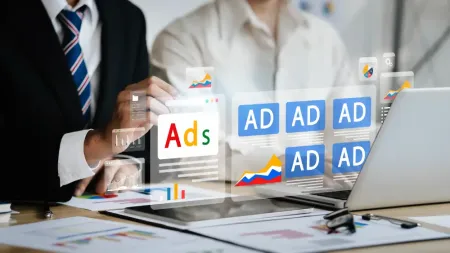How Much Do Google Ads Cost? | A Guide for Businesses

In 2025, Google Ads can be a valuable tool for businesses, but understanding the cost implications is essential. Monthly Google Ads expenses typically range from $100 to $10,000, providing flexibility depending on your advertising strategy. Cost per click (CPC) generally falls between $1 and $2, but these figures can fluctuate significantly based on factors such as industry competitiveness, keyword selection, and geographic targeting.
Given this variance, businesses must set a realistic budget for their advertising campaigns. A well-planned budget can help optimize your spending and maximize return on investment. Remember that effective Google Ads advertising requires ongoing monitoring and adjustments to align with your financial goals. By accounting for these costs and establishing a strategic budget, businesses can navigate the dynamic landscape of Google Ads in 2024 and achieve their marketing objectives efficiently.
What are Google Ads?

Google Ads, formerly known as Google AdWords, is a robust paid advertising program from Google designed to help businesses of all sizes enhance their online visibility. Through targeted keyword bidding, advertisers can reach potential customers actively searching for products or services they offer.
The functionality of Google Ads revolves around matching ads to specific user search queries. When individuals enter keywords relevant to a business, Google’s algorithms display the most pertinent ads, increasing the chances of engagement and conversion. This targeted approach ensures that businesses are not just reaching a broad audience but are connecting with those genuinely interested in their offerings.
Beyond traditional text ads, Google Ads offers a diverse range of advertising platforms, including display, video, shopping, and app promotion ads. This versatility allows businesses to effectively communicate their message across various digital spaces, making it a powerful tool in the digital marketing landscape. In essence, Google Ads provides a strategic way for businesses to boost their online presence and drive relevant traffic to their websites.
What is the process behind Google Ads?

Google Ads operates through an ad auction process that determines ad placement and cost per click (CPC). Advertisers bid a specific amount for keywords they wish to target. However, the bid amount alone doesn't guarantee top placement; it's combined with the Quality Score, which measures the relevance of the ad, the expected click-through rate, and the landing page experience.
Ad rank, which determines the ad's position on the search results page, is calculated using the formula: bid amount × quality score. A higher quality score can lead to better ad positions at lower costs, allowing advertisers to outperform competitors with higher bids but lower relevance.
Additionally, ad extensions enhance ad visibility and relevance, providing more information for users and potentially increasing click-through rates. These factors collectively affect both placement and CPC, making relevance crucial for success in Google Ads.
What is the cost of Google Ads?

Google Ads costs can vary significantly based on several factors, including the average cost per click (CPC) across different networks. Businesses typically allocate $9,000 to $10,000 per month to Google Ads, with total ad spend influenced by industry competition, targeting options, and campaign goals.
Small to medium-sized businesses may see varying results based on their investment and strategy. Professional PPC management from an advertising agency can optimize ad performance, ensuring effective targeting and budget allocation. A skilled agency can leverage data analytics (Google Analytics) to refine ad campaigns, helping businesses achieve better conversion rates and return on ad spend.
Four Factors That Influence Google Ad Costs

When it comes to Google Ads, several critical factors influence pricing, which can significantly affect a business's advertising budget and overall marketing strategy. Understanding these factors is essential for advertisers aiming to optimize their campaigns and achieve maximum return on investment. The key elements that determine Google Ads pricing include keyword selection and competition, ad quality and relevance, and overall market trends and seasonality. Each of these factors plays a vital role in how much advertisers will pay for their desired ad placements, influencing not only the cost but also the effectiveness of their campaigns.
1. Industry
The cost per click (CPC) in Google Ads varies significantly across industries, largely influenced by each sector's competitiveness. For instance, competitive industries such as finance and legal services often experience higher CPCs, averaging between $10 and $50. This is because the potential revenue generated from acquiring a single client can be substantial, incentivizing companies to bid aggressively for top placements.
In contrast, B2B advertising typically incurs lower CPCs, often averaging $3 to $6. B2B companies focus on niche markets, allowing for more targeted advertising strategies. This specificity helps lower competition and, consequently, costs while effectively reaching their desired audience.
2. Customer lifecycle
The customer lifecycle encompasses the stages potential clients navigate before making a purchase, including awareness, consideration, and decision-making. During this journey, staying top of mind through multiple interactions—such as website visits, content downloads, and webinars—is crucial for building relationships and trust.
For businesses with higher-ticket offerings, the length of this decision-making process can significantly affect Google Ads costs. Longer cycles may require sustained advertising to keep potential clients engaged, leading to increased spending on Google Ads to remain visible across the various stages.
To maintain engagement, implement strategies like targeted email campaigns that follow up on website visits or content downloads, and host informative webinars to further educate prospects. Regularly updating your website with valuable resources can also encourage repeat visits and cultivate a sense of community.
3. Current trends
Current trends in digital advertising are marked by significant fluctuations in cost-per-click (CPC) and cost-per-thousand (CPM) rates, primarily driven by events such as COVID-19. As businesses adapted to shifting consumer behavior during the pandemic, CPC rates surged across sectors, including the bike industry, where increased demand for cycling led to heightened competition and higher advertising costs.
To navigate rising costs, businesses must optimize their mobile advertising strategies as more consumers engage with content on their smartphones. Effective mobile campaigns can improve the user experience and increase conversion rates. Additionally, leveraging machine learning technologies enables businesses to analyze consumer data more accurately, predict trends, and optimize ad placements, thereby achieving better ROI.
4. How well do you manage your account?
Effectively managing your Google Ads account is crucial for optimizing ad performance and maximizing your return on investment (ROI). A well-structured account helps ensure campaigns are organized and targeted to relevant audiences, leading to better conversions and improved performance. Regular audits are key to identifying underperforming ads and areas for improvement, enabling strategic adjustments.
A targeted approach to keyword optimization is critical. Selecting and continuously refining the right keywords improves ad relevance and boosts click-through rates, which ultimately increases ROI. Additionally, setting a daily budget is essential for controlling spending and allocating funds efficiently across campaigns.
Ad extensions are another powerful tool for enhancing performance, providing extra information that can increase visibility, engagement, and overall ad performance.
Consider PPC Agency Services: While effective account management can be done in-house, a PPC agency can provide specialized services to boost success. These include A/B testing, in-depth keyword research, negative keyword targeting, conversion tracking, and landing page creation. Each of these strategies plays a vital role in driving better results and improving the efficiency of your ad campaigns.
How does Google Ads calculate your cost per click?
In the competitive landscape of online advertising, understanding how Google Ads determines your cost per click (CPC) is crucial for optimizing your campaigns and maximizing return on investment. Google Ads uses a sophisticated auction system that considers various factors to determine CPC rates, enabling advertisers to bid for ad placements. Key components influencing CPC include Quality Score, which measures the relevance and performance of your ads, keywords, and landing pages; your maximum bid; and competitors’ bids in the auction.
1. Quality Score
Quality Score is a critical metric in Google Ads that measures the relevance and quality of your ads, keywords, and landing pages. It directly influences ad performance and cost-per-click (CPC). Quality Score evaluates three key factors: ad relevance, expected click-through rate (CTR), and landing page experience. A higher Quality Score indicates that your ads are closely aligned with user searches, resulting in improved visibility and lower costs.
To enhance Quality Score, optimizing landing pages is essential. A well-structured landing page that delivers a seamless user experience not only keeps visitors engaged but also satisfies their search intent. Additionally, selecting relevant keywords ensures that your ads are displayed to the right audience.
2. Ad Rank
Ad Rank is a crucial factor in determining ad placement in Google search results. It is calculated using the formula: Ad Rank = Quality Score × Maximum Bid. The Quality Score reflects the relevance and quality of the ad, while the Maximum Bid represents the highest amount an advertiser is willing to pay per click. Together, these factors dictate the ad's position on the search result page.
Competitive keywords significantly impact both bidding costs and Ad Rank. High-demand keywords may lead to increased competition, driving up costs and requiring advertisers to optimize their Quality Scores. Advertisers must focus on creating relevant, engaging ads and landing pages to maintain a favorable Quality Score and achieve a higher Ad Rank without necessarily outbidding competitors.
This system empowers small business owners to effectively compete against larger enterprises.
3. Cost per click
Cost per click (CPC) in Google Ads is a crucial metric that determines how much advertisers pay each time a user clicks their ad. CPC is calculated using the formula:
(Ad Rank of the ad below yours ÷ Your Quality Score) + $0.01.
This means that if your competition has a higher ad rank, it directly influences your CPC.
Several factors influence CPC, including:
- Ad quality: assessed through your quality score. A higher quality score indicates better ad relevance and user experience, allowing you to achieve a lower CPC.
- Auction competitiveness: during highly competitive bidding wars, CPC tends to rise.
- Keyword choice: certain keywords can have varying costs based on demand and competition.
To optimize ad performance, focus on improving ad relevance and quality. This not only helps in achieving a lower CPC but also improves overall ad effectiveness and return on investment.
What is the process for budgeting with Google Ads expenses?

Budgeting for Google Ads is a crucial step for businesses looking to maximize their online advertising efforts while effectively managing costs. By understanding how Google Ads costs work, advertisers can set up a budget that aligns with their marketing goals and financial capabilities. Google Ads operates on a pay-per-click (PPC) model, meaning that advertisers only pay when users click on their search ads, which adds a layer of control over spending. The platform allows users to set daily and total campaign budgets, enabling precise control over how much they are willing to spend within specific time frames.
Spending limits
Spending limits in Google Ads are crucial for effective budget management. Advertisers can set a daily average budget, which Google may exceed by up to 100% on high-traffic days to maximize clicks and conversions. This flexibility allows campaigns to capture opportunities without compromising cost control.
Importantly, advertisers will never pay more than their specified daily or monthly spending limits, ensuring that budgets are adhered to and preventing unexpected overspending. For those not using the invoice method, Google Ads also lets you set a monthly spending limit at the account level. This feature provides added security for advertisers, allowing them to manage their expenditures effectively.
Ways to calculate your average daily budget
To determine your average daily budget for a Google Ads campaign, divide your established monthly budget by 30.4. This number represents the average days in a month, giving you a clear view of your daily spending goals.
Your monthly budget is influenced by several factors, including your overall Google Ads budget and the relative importance of each campaign. Prioritize campaigns that align with your business goals to allocate funds effectively.
Utilizing the Google Ads budget report can further enhance your budgeting strategy. This report offers insights into your spending patterns, allowing you to visualize where your budget is going. It also allows you to experiment with different daily budget adjustments, helping you optimize campaign performance and achieve better results.
Daily budget estimates
In Google Ads, a daily budget sets a limit on how much you want to spend each day on your campaigns. However, actual expenditures can vary from day to day. To maintain effective budget pacing, advertisers often calculate an average daily budget by dividing their monthly budget by 30.4, which accounts for the average number of days in a month.
For example, if your monthly budget is $1,500, your average daily budget would be approximately $49.34 ($1,500 ÷ 30.4).
It's crucial, especially for beginners, to set individual budgets for each campaign rather than using a shared budget. This approach allows you to tailor spending to the performance and goals of each campaign, ensuring you allocate resources effectively.
What is the recommended budget for Google Adwords?

The amount spent on Google Ads varies significantly based on industry, business goals, and budget. Each sector has its own unique cost-per-click (CPC) rates and expected revenue per new customer, which impact overall spending strategies. A business aiming for aggressive growth might allocate a larger Google Ads budget, while startups may prioritize lower spending to test the waters.
Starting with a low daily budget is essential for evaluating search ad performance and optimizing campaigns for better ROI. This approach allows businesses to identify which keywords and ads yield the highest conversion rates without overspending on ineffective strategies.
Additionally, understanding competition within your niche can help determine appropriate spending levels. High competition often leads to increased CPCs, warranting a more strategic approach to budget allocation. By focusing on both conversion rates and expected revenue, businesses can fine-tune their online advertising efforts, ensuring that every dollar spent contributes positively to their ROI.
What other advertising strategies are there?
Small businesses can significantly enhance their advertising strategies beyond traditional ads by leveraging innovative approaches tailored to their target audience, like print marketing. Conducting thorough research is crucial for understanding customer behavior and preferences, enabling businesses to craft compelling, relevant messaging. Testing various formats, such as video ads, enables dynamic storytelling that effectively engages viewers, while local service ads help businesses connect with nearby customers actively seeking their services.
Exploring diverse advertising formats, including shopping and app ads, offers opportunities to reach potential customers through various channels, maximizing exposure. Implementing A/B testing across campaigns helps pinpoint what resonates most with the target audience, ensuring resources are allocated effectively for optimal ROI.
Digital and Print Marketing with Coalmarch
Coalmarch recognizes the unique advantages of digital and print marketing, especially in industries like pest control and lawn care. Here are some key benefits of integrating digital and print marketing with Coalmarch:
1. Increased Brand Visibility: By combining digital and print marketing strategies, businesses can enhance their brand presence in both online and offline spaces. This dual approach ensures that potential customers encounter the brand through multiple touchpoints, leading to greater recognition and recall.
2. Targeted Outreach: Utilizing both digital and print marketing allows businesses to reach specific demographics more effectively. By analyzing customer data and behavior, companies can tailor their messaging to resonate with their target audience, whether through online ads or localized print materials.
3. Enhanced Customer Engagement: Integrating digital platforms with print materials creates opportunities for interactive experiences. For instance, QR codes on flyers can direct customers to websites or social media pages, encouraging them to engage further with the brand. This synergy enhances customer engagement by seamlessly connecting offline and online experiences.
4. Enhanced Credibility: Another significant advantage of combining digital and print marketing. Print materials, such as brochures or flyers, often convey a sense of permanence and trustworthiness, enhancing a brand's credibility. When customers see a consistent message across both digital platforms and printed materials, it reinforces the brand's reliability and professionalism.
5. Cost-effective Marketing: Utilizing both digital and print marketing can lead to cost savings by optimizing resource allocation across different channels. By strategically investing in both areas, businesses can reach a wider audience without overspending on any single platform. This diversified approach allows for better budgeting and potentially higher returns on investment.
Closing Thoughts
In today's competitive landscape, understanding the costs and intricacies of Google Ads in 2024 is imperative for businesses aiming to make informed decisions about their advertising budgets. While investing in digital ads can yield significant returns, integrating them with traditional print marketing strategies can create a holistic approach that amplifies brand visibility and engagement.
Partnering with Coalmarch provides businesses with expert guidance to navigate this complex advertising landscape. With their knowledge of both digital and print marketing, Coalmarch can help you maximize your reach and customer targeting effectiveness. By leveraging data-driven insights, they can help optimize ad campaigns on platforms like Google Ads and integrate print materials that reinforce your brand message. Take your business to the next level. Contact us today!




